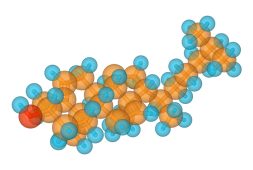
Particulate Matter In Relation to Breast Cancer
Breast cancer ranks as the most widespread malignancy among women worldwide, affecting over 7.8 million individuals across the globe. This disease knows no geographical boundaries, striking women post-puberty and becoming more prevalent in later life. It manifests through telltale signs such as breast lumps, alterations in breast or nipple texture or shape, and occasionally, nipple discharge tinged with blood.
Breast cancer is a diverse ailment, influenced by various established risk factors. These factors encompass a woman’s reproductive history, alcohol consumption, obesity, and the use of external hormones. The consistency of these risk factors with the disease’s origins raises the possibility that environmental pollutants with endocrine-disrupting capabilities may play a role in modulating or instigating breast cancer. Notably, airborne particulate matter measuring less than 2.5 µm in diameter (PM2.5) has been categorized as a confirmed human carcinogen by the International Agency for Research on Cancer, although most of this evidence has been drawn from studies on lung cancer. The connection between PM2.5 and breast cancer remains a matter of debate.
Fine particulate matter represents a complex mixture of numerous pollutants, including metals (e.g., nickel, sodium), metalloids (e.g., silicon), ammonium, ozone, organic compounds, nitrates, and sulfates. Although recent research has pinpointed nitrogen dioxide (NO2) as an airborne carcinogen, investigations regarding fine particulate matter’s role remain scarce and inconsistent. Some studies fail to establish a link between PM2.5 and breast cancer risk, while others report a positive correlation. Furthermore, the limited existing research often concentrates on current or short-term exposure, disregards regional variations in air quality, and omits tumor subtype analyses.
Given the widespread occurrence of breast cancer and the steadily rising global incidence rates, it is imperative to conduct research aimed at identifying the causal factors behind this condition. Such research holds the potential to guide policy interventions aimed at curbing the spread of this potentially fatal disease.
All About the Study
The primary aim of this study was to explore the link between historical concentrations of PM2.5 (particulate matter with a diameter of 2.5 micrometers or smaller) and the risk of breast cancer within a large and geographically diverse cohort in the United States. Additionally, as a secondary objective, the study sought to identify any connections between air pollution and specific subtypes of breast cancer, categorized based on their estrogen receptor profiles.
The study utilized data from participants who were part of the National Institutes of Health (NIH)-AARP cohort. Initially, in 1995-96, questionnaire data were collected regarding the participants’ anthropometric and demographic characteristics. Follow-up data were subsequently gathered from 2004 until the completion of the study on December 31, 2017. Information on cancer diagnoses and participants’ places of residence were collected from various sources, including hospital medical records, state cancer registries, and the US Postal Service (USPS) National Change of Address database.
After excluding proxy responses, male participants, and individuals who self-reported cancer at the start of the study, the final cohort consisted of 196,905 adult female participants hailing from six states (Florida, California, New Jersey, Louisiana, North Carolina, and Pennsylvania) and two metropolitan areas (Detroit, MI, and Atlanta, GA). To construct and validate the spatiotemporal PM2.5 prediction model for this study, data on temporally informative PM2.5measurements were obtained from the Interagency Monitoring of Protected Visual Environment (IMPROVE) network (1999-2010) and the US Environmental Protection Agency’s Federal Reference Method (FRM) network (1999-2010).
To estimate temporal trends in PM2.5 concentrations during the years 1980-2010, geographic predictors, in conjunction with spatial smoothing techniques, were applied. This was necessary when data were unavailable from the aforementioned agencies or from the Clean Air Status and Trends Network (1987-2010) and Weather Bureau Army Navy network visual ranges (1980-2010). For statistical analysis, the historical PM2.5 exposure (prior to the study’s commencement) was divided into three 5-year periods: 1980-1984, 1985-1989, and 1990-1994. Spearman correlations were employed, along with the calculation of frequencies and proportions for categorical variables, as well as mean and standard deviations for continuous variables.
Breast cancers were categorized based on their estrogen receptor status into ‘ER+’ and ‘ER-‘, and further classification was made based on the extent of the tumor as ‘invasive’ or ‘Ductal carcinoma in situ (DCIS).’ The association between PM2.5 and breast cancer was elucidated using the Cox proportional hazards regression model. All models were adjusted for various factors, including age, race, ethnicity, smoking status, body mass index (BMI), educational level, and geographical catchment area. Recognizing the potential influence of air pollution on minority communities, race and ethnicity were considered confounding variables, while other sociodemographic and anthropometric characteristics were treated as covariates.
The study’s model heterogeneity was assessed through stratified analyses, and sensitivity analyses were conducted to evaluate the robustness of the models.
Findings of the Study
During the extensive 20.7-year follow-up period of this research, the investigation identified 15,870 cases of breast cancer, accounting for 8% of the study’s participant cohort. Among these cases, 14,621 were postmenopausal women, representing 92% of the total, and their average age was 61.8 years. The majority, specifically 89%, belonged to the White ethnicity. Furthermore, 30% of these women had pursued education beyond college, and the majority were residents of either Florida (21%) or California (32%). An analysis of potential confounding factors revealed that although Black women constituted only 6% of the cohort, they tended to reside in areas with the highest PM2.5exposure.
In a noteworthy development, the study uncovered a reduction of approximately 17% in PM2.5 levels between 1980 and 1994. Nevertheless, the long-term consequences of PM2.5 exposure were evident, with findings indicating that a 10 µg/m3 increase in fine particulate matter exposure during the 1980-84 period corresponded to an 8% elevated risk of breast cancer. Further analysis suggested that P PM2.5 heightened the risk of ER+ breast cancers but did not influence the risk of ER- cancers. No statistically significant connection was established between air pollution and the occurrence of DCIS or invasive breast cancers.
One of the primary limitations of this study pertained to the composition of the study cohort. The NIH-AARP study recruited participants who had already retired, with the youngest being 50 years old. Consequently, the research could not account for the impact of PM2.5 exposure in younger women, whose physiological responses to varying levels of air pollution might differ. Nonetheless, this study provides compelling evidence that PM2.5 exposure directly contributes to the risk of developing ER+ breast cancer in the future. This underscores the importance of implementing policies at the administrative level and adopting behavioral changes at the individual level, such as the use of face masks, to safeguard against these nearly imperceptible yet perilous pollutants.
Conclusion
In this recent research endeavor, scientists leveraged demographic and anthropometric information sourced from a cohort of 196,905 adult women. Their primary aim was to scrutinize the potential cancer risk within this group over the period spanning from 1980 to 2010. Employing spatiotemporal modeling techniques, the team unearthed a noteworthy association between historical air pollution levels and cancer incidence. Specifically, their analysis unveiled that a mere 10 µg/m3 rise in PM2.5 concentrations corresponded to an 8% elevation in the risk of developing breast cancer, specifically of the ER+ subtype.



